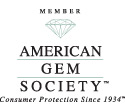Gemology FAQ
What is a Gemologist?
A Gemologist is someone who has attained a professional diploma from an accredited institution that teaches Gemology, the art and science of gems. Gemology includes the study of the history, physical nature and chemistry, and identifying characteristics of gem minerals and materials. In addition, the Gemologist learns to identify, grade and evaluate gems.
A Gemologist may or may not sell gems. Accurately pricing and valuing gemstones based on the current marketplace falls into the realm of an Appraiser, which is a related area of expertise. A Gemologist-Appraiser is a specialist trained in both fields, able to give the most accurate information possible.
What is a gem?
A gem is a valuable and beautiful object fashioned from materials of nature and used primarily in jewelry. These materials are usually crystalline minerals mined from the earth. Non-crystalline minerals such as opal and obsidian, and biological materials such as amber are also used to fashion gems. The raw material, whether crystal or otherwise, is shaped and polished to bring out its inherent beauty and to render it into an attractive and usable shape. The three most important criteria of gems are that they be beautiful, rare and durable.
What is the difference between precious and semiprecious gems?
The historical “ranking” of gems - that Diamond, Ruby, Emerald, Sapphire, and Pearl were considered “precious” and all others ”semiprecious” - is not valid in the modern world for several reasons. First, of the many new gems discovered in the last 100 years, most are quite beautiful, rare and durable. Gems such as Tanzanite or Tsavorite can easily sell for thousands of dollars, so who is to say they are not precious? Furthermore, a high quality Garnet or Tourmaline can be much more valuable than a low quality Ruby or Emerald.
What is the most expensive gem?
Diamond is in most cases most valuable, but factors like size, quality, and rarity can easily change the equation. For example, a top quality 3-carat Ruby from Burma can easily equal the price of a Diamond of similar size and quality. An Alexandrite of large size and excellent quality can be extremely valuable. Additionally, provenance can add significant value to a gem.
How are gems graded?
Gems are graded by Gemologists and gem merchants according to commonly accepted systems where the color, relative purity, and optic characteristics are established relative to other gems. Once the relative position of a gem is established, it can be valued. Most gems are valued by their exact weight, at so many dollars per carat.
What are gem treatments?
Many types of gemstones are routinely treated to enhance their natural beauty. There are a wide variety of common treatments, which you can learn more about by reading our Gem Treatment Information.
What is the difference between carat and karat?
Carat is an measurement of weight used to weigh gems. One carat is equal to 200 milligrams metric. One carat is often broken down into 100 “points,” like pennies to a dollar. 50 points is exactly 1/2 carat.
Karat is an ancient ratio of purity used only for gold alloys. “24 karat” refers to pure gold, which is not often used in jewelry due to its malleability. Gold is usually alloyed with other metals to make it harder or modify its color. An 18 karat alloy contains 18 parts of 24 of gold, and is therefore 75% gold.
Have a question that isn’t answered above? Feel free to Ask A Gemologist!







